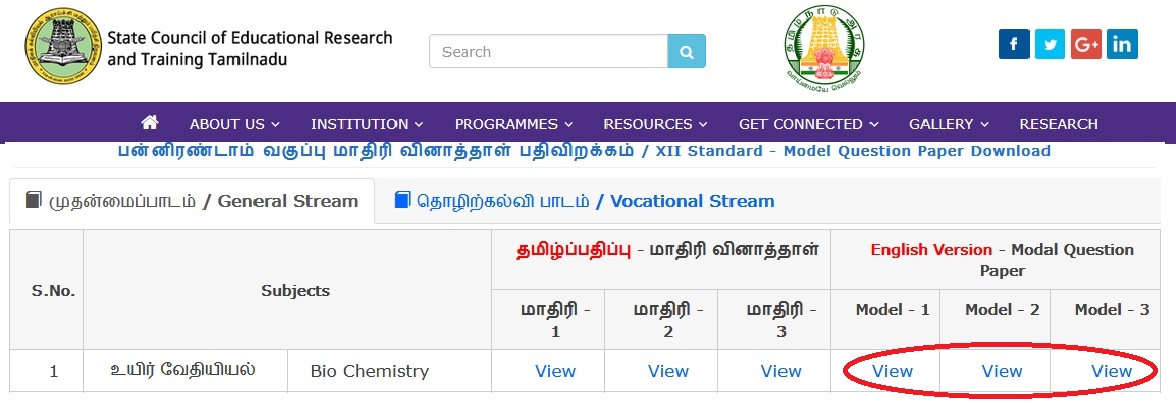TNSCERT XII Standard Bio Chemistry Model Question Paper 2019 : Educational Research & Training Tamilnadu
Organisation : State Council of Educational Research and Training Tamilnadu
Exam : Higher Secondary Second Year
Document Type : XII Standard – Model Question Paper Download
Category or Subject : Bio Chemistry
Website : http://www.tnscert.org/webapp2/xiimodelquestionspaper.aspx
TNSCERT XII Standard Bio Chemistry Model Question Paper
The Government of Tamil Nadu has taken a policy decision on reducing the maximum marks for Higher Secondary Board Examination from 1200 to 600 in order to reduce the examination stress of students besides reducing the number of papers for Language subjects from two to one.
Related : TNSCERT XII Standard Microbiology Model Question Paper 2019 : www.pdfquestion.in/34036.html
Note :
** These are only model questions. Teachers and students need to focus only on the Pattern of the questions.
Bio Chemistry
Time : 2.30 Hours
Marks : 70

PART – A
Answer all the questions
Choose The Correct Answer : 15 x 1 = 15
1. Erythrocyte fragility test is based on the principle of ________
a) Surface tension
b) osmosis
c) viscosity
d) buffering action
2. Which one of the pair of enzymes is example for an endopeptidase
a) amylase and lipase
b) Gastrin and esterase
c) nuclease and rennin
d) pepsin and trypsin
3. D amino acids are absorbed by
a) Passive diffusion
b) active transport
c) both of them
d) none of the above
4. At the time of starvation _____ undergoes glyconeogenesis?
a) glycine
b) glycerol
c) propionate
d) sucrose
5. Translocation is catalysed by the enzyme____
a) RNA polymerase
b) helicase
c) ligase
d) translocase
Download Question Paper :
Model – 1 :
https://www.pdfquestion.in/uploads/pdf2019/34041-BioC1.pdf
Model – 2 :
https://www.pdfquestion.in/uploads/pdf2019/34041-BioC2.pdf
Model – 3 :
https://www.pdfquestion.in/uploads/pdf2019/34041-BioC3.pdf
6. _____ is an example for biogenic amines
a) Tryptophan
b) Histamine
c) Alanine
d) Tyrosine
7. Atherosclerotic individuals will have _______ in plasma
a. LDL, VLDL
b. Wax and fatty acids
c. HDL and EFA
d. Lysolecithin
8. Which one is a saturated acid?
a) oleic acid
b) cerebronic acid
c) nervonic acid
d) stearic acid
9. G-C rich region followed by A-T rich region is a signal for
a) initiation
b) elongation
c) termination
d) primer termination
10. The metabolite that accumulates in Taysach’s disease in _______
a) galactose
b) tyrosine
c) ganglioside
d) glucose
11. Succinate dehydrogenase in mitochondria is a marker of
a) outer membrane
b) inner membrane
c) matrix
d) inter membrane space
12. When FADH2 is the substrate in ETC, ______ molecules of ATP are formed
a) 3
b) 2
c) 4
d) 7
13. The reciprocal of Michaelis Menton equation was considered by
a) lineweaver Burk
b) Fischer
c) Koshland
d) Dixon
14. In AIDS, the cells which are affected by HIV
a) mast cells
b) T helper cells
c) T suppressor cells
d) B memory cells
15. The causative agent of pneumonia in _______
a) Adeno virus
b) mumps virus
c) Rabies virus
d) Varicella
PART – B
Answer any six in which Q No 23 is compulsory : 6 x 2 = 12
16. Write about Hay’s test?
17. Write about the digestion of nucleic acids in small intestine
18. How pyruvate is converted to lactate?
19. What is the other name of Niacin? How is it synthesized from Tryptophan?
20. What are essential fatty acids? Write their functions. Give examples.
21. Write any three differences between replication and transcription.
22. Write the cause of Galaotosemia.
23. What is irreversible enzyme inhibition?
24. What are haptens?
PART – C
Answer any six in which Q No 28 is compulsory : 6 x 3 = 18
25. Explain Starling’s hypothesis.
26. Write a note on Gastrin.
27. Calculate the energy field per glucose molecule upon oxidation in glycolysis.
28. How is methionine converted to active methionine?
29. How are Bile salts formed?
30. Write a short note on Exonucleases.
31. What are tumour markers? Given an example.
32. Define oxidative phosphorylation.
33. What are the role of antigen presenting cells?
PART – D
Answer all the questions : 5 x 5 = 25
34. Explain the arrangements of proteins in the cell membrane.
(or)
Write the equations involved in the conversion of glucose – 6 – phosphate to D – Ribose 5 phosphates in HMP shunt.
35. Explain the action of enzymes present in the small intestine to hydrolyse the carbohydrates.
(or)
Write a note on synthesis of Lecithin.
36. What is meant by transamination? Explain with suitable examples .
(or)
Explain Non competitive inhibition with suitable diagram.
37. Explain Phagocytosis. (or)
Write about the cause and pathology of Vonhierke’s disease.
38. What is the role of t RNA in protein synthesis?
(or)
How will you prove that ATP is the high energy compound?